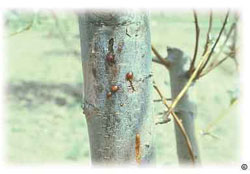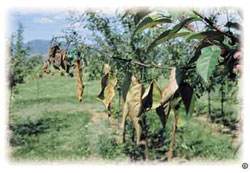What is fireblight?
Fireblight is a bacterial disease that affects apple, crabapple, mountain ash and pear trees. It can kill branches and even whole plants if not treated.

What trees are not affected by fireblight?
Cherry, peach and other related species are NOT affected by fireblight.
What brings on fireblight?
Springtime weather that is warm and rainy encourages fireblight. Bees and other pollinators may introduce the disease to blooming trees during pollination. As a result, symptoms often begin in the blossom, which develop brown, mushy-looking petals.
What happens to trees when they get fireblight?

More commonly, trees with fireblight develop curling, bending and blackening shoots, called shepherd’s crooking. Leaves turn yellow, then brown and finally black but remain on the branch.
How can I manage fireblight?
Manage fireblight by pruning diseased parts of the tree. Prune fireblighted trees as soon as symptoms develop in the spring and early summer. If pruning during the growing season, when the disease is active, it is extremely important to sanitize pruning tools BETWEEN EACH AND EVERY CUT. Dip tools in household bleach or ethyl alcohol or use household spray disinfectants. Prune twigs and branches 8 to 12 inches below visible infection.
Chemical control of fireblight is an option, but it’s not always effective. Copper sulfate can be used before leaves form in early spring. Follow label directions carefully.
Selecting fireblight resistant varieties of apples, pears, and crabapples is a good way to minimize the chances of fireblight infection.
For more information, see the following Colorado State University Extension fact sheet(s).
For more information, view the video:



